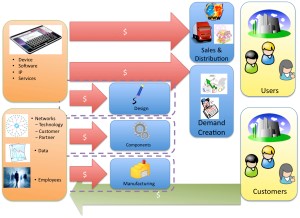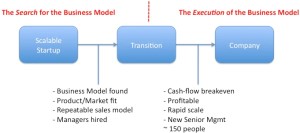
I was catching up with an ex-graduate student at Café Borrone, my favourite coffee place in Menlo Park. This was the second of three “office hours” I was holding that morning for ex-students. He and his co-founder were both PhDs in applied math who believe they can make some serious inroads on next generation search. Over coffee he said, “I need some cheering up. I think my startup is going to fail even before I get funded.” Now he had my attention. I thought his technology was was potentially a killer app. I put down my coffee and listened.
He said, “After we graduated we took our great idea, holed up in my apartment and spent months researching and writing a business plan. We even entered it in the business plan competition. When were done we followed your advice and got out of the building and started talking to potential users and customers.” Ok, I said, “What’s the problem?” He replied, “Well the customers are not acting like we predicted in our plan! There must be something really wrong with our business. We thought we’d take our plan and go raise seed money. We can’t raise money knowing our plan is wrong.”
I said, “Congratulations, you’re not failing, you just took a three and a half month detour.”
Here’s why.
No Plan Survives First Contact With Customers
These guys had spent 4 months writing a 60-page plan with 12 pages of spreadsheets. They collected information that justified their assumptions about the problem, opportunity, market size, their solution and competitors and their team. They rolled out a five-year sales forecast with assumptions about their revenue model, pricing, sales, marketing, customer acquisition cost, etc. Then they had a five-year P&L statement, balance sheet, cash flow and cap table. It was an exquisitely crafted plan. Finally, they took the plan and boiled it down to 15 of the prettiest slides you ever saw.
The problem was that two weeks after they got out of the building talking to potential customers and users, they realised that at least 1/2 of their key assumptions in their wonderfully well-crafted plan were wrong.
Why A Business Plan Is Different Than A Business Model
As I listened, I thought about the other startup I had met an hour earlier. They also had been hard at work for the last 3½ months. But they spent their time differently. Instead of writing a full-fledged business plan, they had focused on building and testing a business model.
A business model describes how your company creates, delivers and captures value. It’s best understood as a diagram that shows all the flows between the different parts of your company. This includes how the product gets distributed to your customers and how money flows back into your company. And it shows your company’s cost structures, how each department interacts with the others and where your company can work with other companies or partners to implement your business.
This team had spent their first two weeks laying out their hypotheses about sales, marketing, pricing, solution, competitors, etc. and put in their first-pass financial assumptions. It took just five PowerPoint slides to capture their assumptions and top line financials.

This team didn’t spend a lot of time justifying their assumptions because they knew facts would change their assumptions. Instead of writing a formal business plan they took their business model and got out of the building to gather feedback on their critical hypotheses (revenue model, pricing, sales, marketing, customer acquisition cost, etc.)
They even mocked up their application and tested landing pages, keywords, customer acquisition cost and other critical assumptions. After three months they felt they had enough preliminary customer and user data to go back and write a PowerPoint presentation that summarised their findings.
This team had wanted to have coffee to chat about which of the four seed round offers they had received they should accept.
A Plan Is Static, A Model Is Dynamic
Entrepreneurs treat a business plan, once written as a final collection of facts. Once completed you don’t often hear about people rewriting their plan. Instead it is treated as the culmination of everything they know and believe. It’s static.
In contrast, a business model is designed to be rapidly changed to reflect what you find outside the building in talking to customers. It’s dynamic.

“So do you mean I should never have written a business plan?” asked the founder who had spent the time crafting the perfect plan.
“On the contrary,” I said. “Business plans are quite useful. The writing exercise forces you to think through all parts of your business. Putting together the financial model forces you to think about how to build a profitable business. But you just discovered that as smart as you and your team are, there were no facts inside your apartment. Unless you have tested the assumptions in your business model first, outside the building, your business plan is just creative writing.”
[This post by Steve Blank first appeared on the official website and has been reproduced with permission.]


























